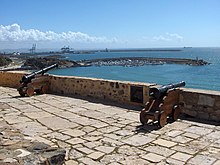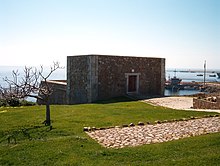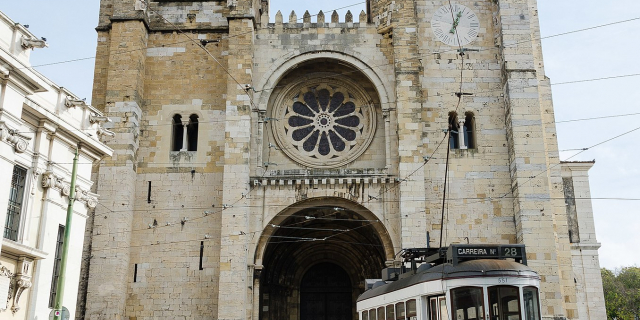Sines (Portuguese pronunciation: [ˈsinɨʃ] ) is a town and a municipality in Portugal. The municipality, divided into two parishes, has around 14,214 inhabitants (2021) in an area of 203.30 km2 (78.49 sq mi). Sines holds an important oil refinery and several petrochemical industries. It is also a popular beach spot and the main fishing harbour of Alentejo region.
The municipality is bordered to the north and east by the municipality of Santiago do Cacém, south by Odemira and west by the Atlantic Ocean. The coastline of the city, south of São Torpes, is part of the Southwest Alentejo and Vicentine Coast Natural Park.
 The ancient centre of Sines: the castle was initiated as protection from pirates in 1362
The ancient centre of Sines: the castle was initiated as protection from pirates in 1362Vestiges of a few settlements have today been discovered in archaeological sites, such as Palmeirinha and Quitéria, that attest to the age of human settlements in Sines.[1] Arnaldo Soledade (1981) noted that these Visigoths, identified as Cinetos, may have been the original civilization that gave rise to the community, suggesting the local toponymy may have derived from this; Cinetos, to Cines and, finally, Sines.[2] Although this tribes lineage is not clearly defined, Soledade goes on to refer to the construction of a castro where the current Castle stands.
The Punics are thought to have also had a presence in the area; a Punic artifact, the Tesouro do Gaio was unearthed in 1966, and is on display in the Museu de Sines (English: Sines Museum). Discovered in May 1966, the 'treasure' was unearthed by a local farmer, Francisco da Silva Campos, who was tilling his land to plant corn, and discovered a schist tomb with women's jewellery in his plot of land in Herdade do Gaio (12.5 km southeast of Sines, 7 km from the coast and 275m from Ribeira de Morgavel).
Between 1966 and 1967, investigator José Miguel da Costa discovered several of these Punic graves, but all showing evidence of early tomb raiding. While the jewellery was determined to be Punic in origin, the symbolism on the artefacts were characterized as Egyptian.[3] On the island of Pessegueiro, there is also evidence of Ibero-Punic artefacts discovered under the Roman port, discovered by archeologists Carlos Tavares da Silva and Joaquina Soares (1981).[4] Roman occupation brought the destruction of many of these artefacts associated with the Iron Age.
The Romans used Sines as a port and industrial centre; the bay of Sines was used as port by the civitas of Miróbriga and the canal on the island of Pessegueiro is linked to Arandis (Garvão). During Rome's occupation, Sines and the island of Pessegueiro, were poles within an industrialized fishing industry which included salting fish. The Roman centres were thought to have been at Praça Tómas Ribeiro, as well as the area around Monte Chaos in Feteira Cima (although little explored archaeologically). In the fields of Quitéria, Carlos Tavares da Silva and Joaquina Soares (1981) investigated the remains of a 1st-century villa, where the remnants of cobblestone streets and a hypocaust were discovered.
In 1961, José Miguel da Costa, during excavations around the Castle of Sines, discovered Roman "fishing factories", and a ceramics kiln to produce amphorae for salted fish, both dating back to the 1st and 2nd centuries. Sine's toponymy is also Roman in origin, but may refer to two terms (both applicable): the term sinus, which means bay; or an alternate meaning for curve, and may refer to the curvature of the Sines Cape, as seen from Monte Chãos.
Middle Ages Battlements along the south wall of the Castle of Sines
Battlements along the south wall of the Castle of Sines The Revelim Fort, the 17th Century fort used for the protection from pirates
The Revelim Fort, the 17th Century fort used for the protection from pirates The old quarter of Sines, showing an example of the older architecture
The old quarter of Sines, showing an example of the older architectureDuring the Middle Ages, the area of Sines was occupied by the Visigoths and later sacked by Moors. There are many more examples of Visigoth-era carved stones (7th century) throughout Sines.[5] Evidence from an archaeological excavation of the Sines castle discovered that many of the walls of the old building were constructed from the rocks used in the construction of Roman-era monuments, such as a portion of a pedestal of a statue of Mars (which was assumed to have been part of a larger square in the Roman town before the construction of the basilica).[6] The basilica itself likely existed on the site of the current Matriz Church, whose baptistery is of Visigothic origin. The Moors likely sacked the settlement in the 7th century; this marked a period of decline in the area, indicating a period when the ancient settlement was abandoned. Yet, although the few inhabitants lived in the zone, Moorish ships regularly patrolled the waters, until the 13th century, when Afonso III conquered the region.
The area regained much of its importance at the beginning of the 8th century, when fishermen returned to the waters around Sines. Re-settlement along the coast was initiated by the Order of Santiago da Espada, who administered the lands under the reign of Afonso III. Sines obtained administrative autonomy from Santiago do Cacém on 24 November 1362, when Pedro I elevated Sines to the status of villa. He later preoccupied himself with the coastal defense of the region, establishing the conditions for the construction of Sine's Castle, already protected by elements of the Visigothic wall. The castle in Sines was constructed during the first half of the 15th century. Like Setúbal, but contrary to what happened in Santiago do Cacém or Palmela, the castle was constructed to defend the wealth of the local merchants, indicating a new economic and social order, with the ascension of the bourgeoisie.[7]
MonarchyDuring the Portuguese Interregnum and 1383–1385 Crisis, the bourgeoisie and nobles of Sines were one of the municipalities that supported the Master of the Order of Aviz, the later King John I of Portugal in his battle for the throne. In 1395, aggravated by the fact the castle was not completed, King John appropriated men to serve in the military campaigns along the frontier. But, much of the concern during this period was from attacks by pirates, and compulsory military service was seen as bulwark against the region's collapse. In 1511, Sines was attacked by a large band of pirates. The King, who was careful to indemnity the losses, established a small base of three ships in Sines and Sesimbra to combat these French privateers. By the end of the 16th century, as threats from the coast increased, so too were the fortifications along the coast. This included the establishment of a fort alongside the Chapel of Senhora das Salas (Fort of Revelim), and two forts on the island of Pessegueiro. In 1629, as the construction of the Revelim Fort proceeded, Turkish pirates attacked and sank a nau in the port of Sines. A Sesimbrense captain, though, was successful in capturing a pirate ship in the bay by 1648.
At the end of the 16th century, commanded by Filippo Terzi, in the service of Philip II of Portugal, it was thought that the construction of a new port on Pessegueiro would motivate growth. Problems during construction, and frequent raids by English privateers, caused the project to be abandoned: the remnants on Pessegueiro include great blocks of rock that were quarried to make way for the project. In the last decade of the 18th century, the natural anchorage seduced Jacinto Fernandes Bandeira, a merchant, to found Porto Covo, with the hope that his initiative would convince others to establish complementary businesses and a grand port.
In the second half of the 19th century, pyrite from Pias and Moinho dos Paneiros (Sines) and ore from Cercal are transported from the small island. The ore arrived in carts pulled by bulls, transported over a large bridge, and by boats to larger ships on the island. Near the mouth of the ravine on Pessegueiro there still remain abandoned deposits of accumulated ore, that were never transported.
During the first decade of the 19th century, the populace of Sines lived in fear during the French occupation of the country. In one incident, a company of troops from Napoleon's army pillaged the town and defaced the royal coat-of-arms over the doors to the castle.
Under the Liberalist Constitution, the municipality began to govern its own affairs, as the Order of Santiago, along with other religious orders were expelled from Portugal in 1855, and most of their assets appropriated. Sines became a parish of Santiago do Cacém, losing autonomy, yet flourished economically as several new businesses began operating from the town. The establishment of cork and canning industries, small factories producing distillates and artisan goods (bakeries and cobblers), turned the village more attractive to emigrants. The town attracted many English and Catalan businesses, as well as Alentejan and Algarvan entrepreneurs in search of work.
Entrepreneurial growth and republican idealism helped to redevelop the area, as the construction of new roads, the arrival of a rail-line, access to schools and culture became cumulative. The new elites, not only built their wealth on land rental, but also industry and commerce, and showed renewed interest in restoring the municipality. These liberal elites, such as João Daniel de Sines, fought for the constitutional monarchy during the Liberal Wars, and were magnanimous when former-King Miguel of Portugal stopped-over in their region on his way to exile.
At the end of the 19th century, a young Algarvian medic would write the first monograph on Sines, Breve Notícia de Sines (English: A Brief Notice on Sines). Francisco Luís Lopes' work was an acidic critique of municipal affairs and living conditions that were both sincere and damning, but also flattering and praise-worthy, noting both the villa's problems and its openness and tolerance.[8]
RepublicThe year 1914 marked a period of renewed interest and the restoration of the municipality. The cork industry, the fishery, some agriculture and tourism marked a period of economic activity that lasted until the end of the 1960s, when, apart from its proximity to the sea, Sines was indistinguishable from other communities in the Alentejo. Sines was the beach for many of the local residents of the Alentejo, visited by the rural families of Beja and Santiago do Cacém.
Until the early 1970s, Sines was a sheltered fishing village with a long commercial history of relations with cities in the Mediterranean; its large marina, along a breakwater, is the only marina between Setúbal and the Algarve, while the deep-sea port, commercial fishery and industrial depot have driven the economy of this area. In 1970, the government of Marcello Caetano initiated the grand industrial-port complex that would, along with the 1974 Revolution, energize the local economy. Consequently, the population exploded, while industry and commerce diversified, causing their own impacts. In the late 1970s, the arrival of immigrants and refugees from the Portuguese overseas provinces brought new social dynamics, which were later supplemented by foreign workers employed in the port and petrochemical industry.

































Add new comment